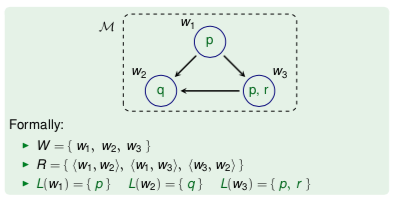Logic and Modeling
Table of Contents
Modal logic
modal logic allows reasoning about dynamics – futures, knowledge, beliefs, etc.
modalities (unary connectives):
- □ (box): sure, always, has to be, knows, guaranteed (kinda like ∀)
- ◇ (diamond): possibly, sometimes, maybe, believes is possible, possible result (kinda like ∃)
Kripke model M = (W, R, L) consists of:
- W worlds
- R accessibility relation
- L labeling function: which propositional letters are true in which world (
w ⊩ p ↔ p ∈ L(w))
Kripke models define truth per world.

Truth in worlds
M, w ⊩ Φ means formula Φ is true in world w of Kripke model M.
◇ Φ is true in world w if there exists a world w’ such that R(w, w’) and Φ is true in w’.
□ Φ is true in world w if Φ is true in all worlds w’ with R(w, w’). special case when world has no outgoing edge, ◇ Φ never holds and □ Φ always holds.
Truth in Kripke models
Φ is true in Kripke model M = (W, R, L) (i.e. M ⊨ Φ), iff x ⊩ Φ for every world x ∈ W.
all propositional tautologies also hold in modal logic.
Semantic implication/entailment
M,w ⊨ ψ in every world w in every Kripke model where M,w ⊨ Φ₁, …, M,w ⊨ Φn.
modal validity: ⊨ ψ if in every world w in ever Kripke model M holds M,w ⊨ ψ.
modal logical equivalence: Φ ≡ ψ if M,w ⊨ Φ ↔ M,w ⊨ ψ. in other words, Φ ≡ ψ ↔ Φ ⊨ ψ and ψ ⊨ Φ.
Frames
frame: Kripke model without labeling. F = (W,R), W worlds, R accessibility relation
Φ is valid in frame F (i.e. F ⊨ Φ) if for every labeling L, Kripke model M = (W,R,L) makes Φ true.
Correspondence of formulas and frame properties
- reflexive:
- F ⊨ □ p → p
- F ⊨ p → ◇ p
- symmetric:
- F ⊨ q → □ ◇ q
- F ⊨ ◇ □ p → p
- transitive:
- F ⊨ □ p → □ □ p
- F ⊨ ◇ ◇ p → ◇ p
- serial:
- F ⊨ ◇ T
- F ⊨ □ p → ◇ p
- functional: □ p ↔ ◇ p